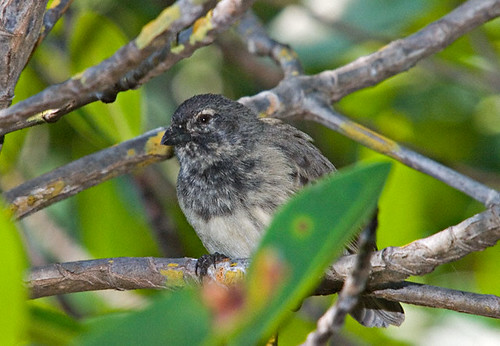
(from here)
One of the models for the evolution of new species is allopatric speciation, where a small isolated population diverges from a larger ancestral population. Many of these peripheral populations become extinct, but some persist and give rise to new species if they can remain reproductively isolated (unable to breed with each other). Lots of things can cause populations to diverge to the point where they can't interbreed, but one key factor is the divergence in sexual signals--that is, individuals don't mate with each other because they don't think they are in the same species (Note: this doesn't have to be the initial source of reproductive isolation. It can simply reinforce other mechanisms of isolation, such as genetic incompatibility and geographic separation).
So what happens if that "larger ancestral population" is, itself, very precarious? Nothing good, and that's what seems to be happening with one of Darwin's finches, Camarhynchus heliobates.
C. heliobates has only about 100 members, and has, during the last century, gone extinct on two of the three islands it was known to live on. So, the recent finding that two populations of C. heliobates are diverging genetically and in terms of mate recognition is not a welcome development. Males and females when presented with recordings from the other populations don't react very strongly, compared to individuals from their own populations. This does not bode well for a species already teetering on extinction:
To date, the surviving birds are confined to two geographically separated populations on Isabela, one on the west coast of the island and a second, very small population on the east coast. The habitat of this species is confined to small, disconnected patches of mangrove that are bordered by the sea on the one side and bare lava on the other. The two remnant mangrove finch populations are geographically separated by more than 70 km of barren lava desert and volcanic mountains. The presence of mangrove finches on the east coast of Isabela was discovered in 1900, thus the two populations have been separated for at least 110 years.
...it might well be that the two mangrove finch populations are already reproductively isolated and could be regarded as two separate species. If so, the eastern species will face imminent extinction because it has an estimated population size of only 5-10 individuals.
We can only hope that the dwindling populations change their tune....
Cross-posted at Research Blogging: Brumm, H., Farrington, H., Petren, K., & Fessl, B. (2010). Evolutionary Dead End in the Galápagos: Divergence of Sexual Signals in the Rarest of Darwin's Finches PLoS ONE, 5 (6) DOI: 10.1371/journal.pone.0011191

"individuals don't mate with each other because they don't think they are in the same species"
Well, that explains a lot about high school, doesn't it? ;)
If a population gets geographically separated into two populations, several things can happen. Speciation may occur. Speciation may not occur. One or both populations may go extinct. Without watching for long enough, one does not know the outcome. It does look like speciation has occurred, but extinction of one species is likely.
But wait! Everybody knows that scientists have never observed the formation of a new species. I know that because I read it in a book by somebody who quotes the Bible a lot, so it must be true.
I was going to cover this one on my own blog, but not only did you beat me to it, you gave it a much better title than I ever would have thought of.
You should really have posts like this aggregated with ResearchBlogging.org.